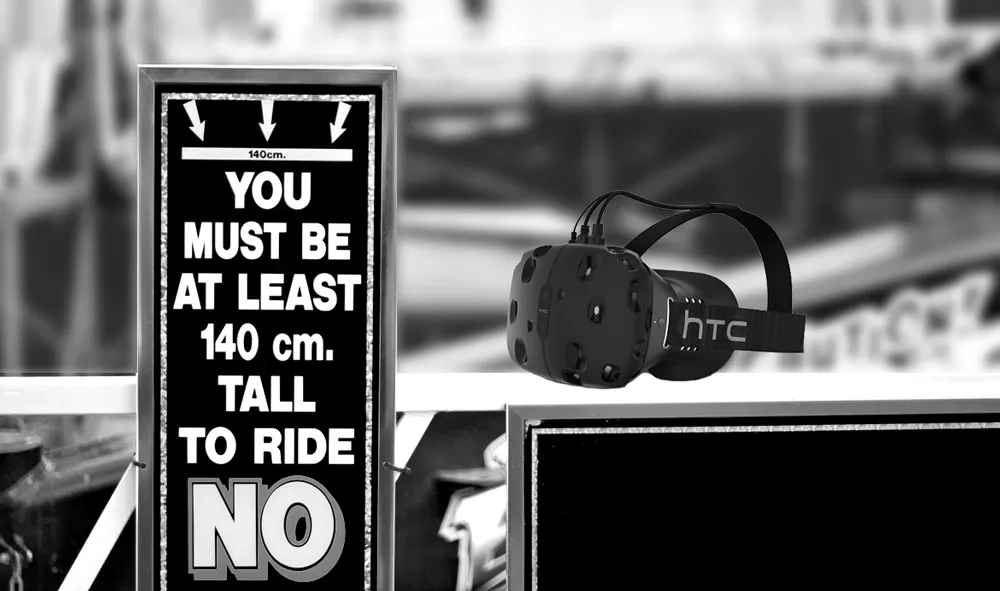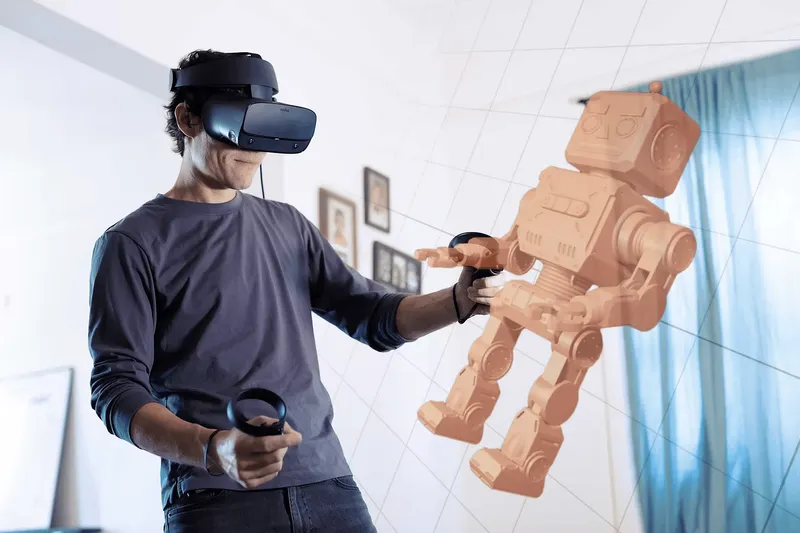Turns out the Vive might have a height limit. Or at least will present developers with some unexpected nuances they will have to work their way around, for example you might find yourself too short or too tall to easily reach elements in the game. Developing at this kind of scale is a new challenge for VR. Actually bringing virtual reality to the constraints of the physical universe is something that the initial Vive demos have done very well, it was something I really felt when I tried TheBlue: The Encounter. In that demo scale was used to dazzle the viewer, with the immense size of the whale. But what about when you are dealing with more normalized scale, like standing in front of a book shelf for example and picking something off a shelf.
We sat down with Joel Green of Cloudhead studios, the creators behind the upcoming VR title The Gallery: Six Elements. The game embraces a Myst-like exploratory gameplay style where you interact in fantastical worlds using your real body. The game itself relies very heavily on bringing 1:1 scale to VR, as naturally interacting with the world is one of the key gameplay elements they looked to create. But bringing that level of immersion and scale to an environment was something that came with it a number of challenges, both for now and for the future. In our interview, Joel elaborates on some of these challenges.
Will: So you guys being one of the first to get your hands on it and develop on it, probably came across some issues and bugs and stuff, but also probably developed some best practices, do you have some best practices for developing for Vive that you can share?
Joel: I think once the actual dev kits come out, they’ll probably be a lot more solid than what we’re working with. We’re basically figuring it all out with Valve. They were getting all this—and other developers. So it’s us and about seven other developers that were all on a forum. We have a big meeting three months ago, they brought us all out there and showed us the tech, and sent us home with the tech. basically it’s been three months of all of us collaboratively figuring it out together and it’s at the point now where it’s pretty solid but I’m sure by the time the dev kits come out it’ll be even more solid.
As far as tips, it’s really the same as like any other full VR experience, like the kind of tips people need to watch out for. There’s a lot of rules that have changed from old school game development. I used to work at Bioware on Dragon Age and Mass Effect series, I’ve been in the game for a little while. Coming onto a VR team and starting to work with this kind of hardware, I’ve had to relearn quite a few things. It’s hard to get into all of them now. It’s just a lot of the design rules have changed. Here’s a good example.
Danny’s kids played it as a test the other day, as a demo, and they were short to reach the machine. So that’s a whole new design problem for video games, that short people are short. Like, I’m tall, so there’s certain things in the level that are hanging in front of my face, and I’m like this is annoying, can we get rid of it? And they’re like, well it’s not a problem, because they’re all down here, and I’m the audio designer, right? I’m the audio director for Bioware as well, so I’m trying to mix the game and the mix is actually different based on how tall you are, because I’m changing things based on the height of where the actual listeners are at, so there’s always new design problems like that have never been encountered before.
We’ve worked around them in a lot of different ways, but it’s kind of a whole new medium, really. There’s a lot.
Height and all these different kinds of things that are a factor. Valve, I don’t know if they’re talking about it just yet, I think they are, but they have this system called chaperone, and essentially what it does, it’s like a third party middleware thing that would be in every game. It basically shows you where the walls are in real life, so they built this as a safety system so that in any one of these demos when you get too close to a wall in real life, you’ll see it show up in the game. So there’s this built in safety layer.
Because that’s built into the steam VR API, it’s going to be basically required. I’m not sure how tight they’ll be—I’m sure people will be able to not use it if they really want to, but you not really want to not use it, because people will literally walk into walls.
Will: How does that work then? Say you’re walking down a hallway in the game and you can only go forward, but you reach the wall, how do you keep going forward?
Exactly. That’s the key issue, right now. Its one of these key core issues right now with room scale VR and it’s something that’s going to require a lot of experimentation to figure out. CloudHead, we consider ourselves pioneers with a lot of different ways of locomotion and VR. Came up with the whole comfort mode thing of how to keep people from feeling sick and sit down VR, and it seems to have been adopted by many people.
We’re experimenting with two ways. Valve has some ideas. They’ve shown us some prototypes. There’s a lot of different ways you can try teleporting players, like moving a whole volume to a new area. We’re probably going to try things like normal stick control to actually have the player go into locomotion mode where they’re actually walking with the whole volume now, so in real life they wouldn’t be walking but in the game they would be. We don’t know how that’s going to work yet. We haven’t had time to experiment with it because we’ve been so focused on making this experience perfect, but I have no doubt that us and many other developers will come up with good solutions to those problems.
Matt: So developers should be open to experimentation?
VR should be all about experimentation. It’s the Wild West. So many of the old rules are out the window, and people really have to rediscover what’s going to work best in VR, and that’s what’s so exciting about it. That’s why we all love working on it every day. We come in and have to solve problems like that that are legitimately difficult problems to solve, but at the same time I’ve seen so many of those problems get solved that seemed impossible at the beginning.
You had controllers and TVs and stuff, it’s weird, it’s abstract to be controlling a character on a screen with a stick and buttons, but we all just accept it as normal, and so those are just problems that somebody solved a long time ago and they became a standard, so we’re kind of at this period in VR where a lot of those standards are out the window and we have to redefine them.
This interview was done in collaboration with Matthew Terndrup (Contributor at UploadVR). Will Mason recorded the audio while we chatted with Joel Green outside the Steam VR demo booths during GDC 2015. Mason also transcribed the audio and wrote up the entire article for publication.




























